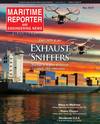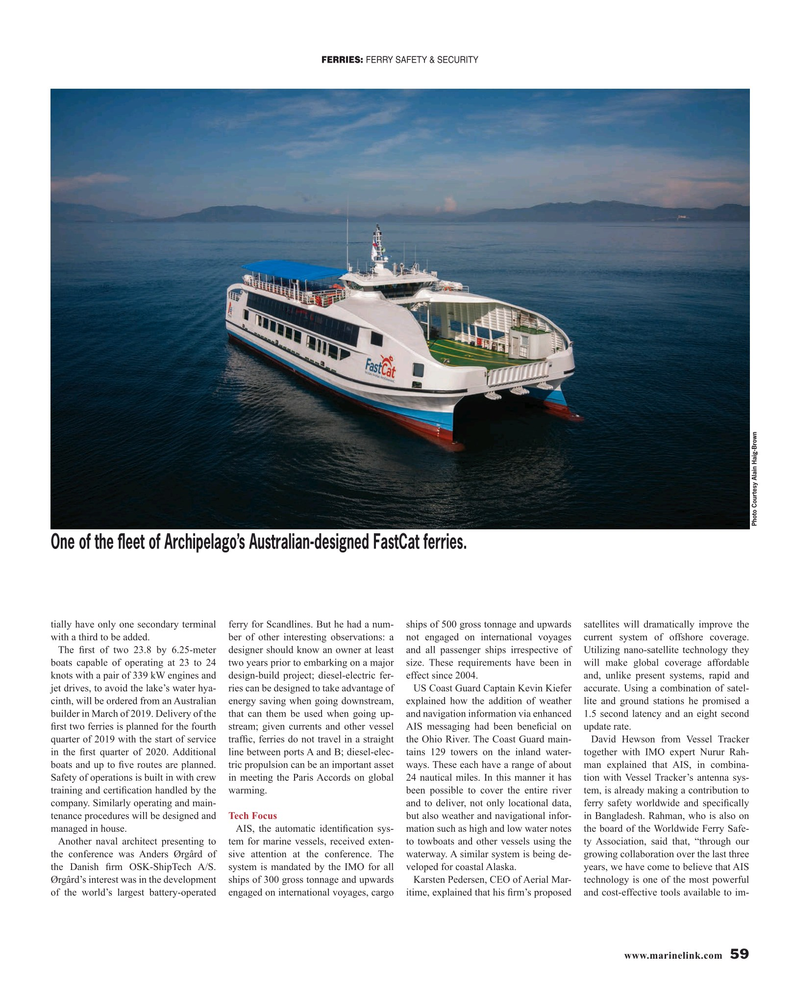
Page 59: of Maritime Reporter Magazine (May 2019)
Propulsion Annual - Green Marine Tech
Read this page in Pdf, Flash or Html5 edition of May 2019 Maritime Reporter Magazine
FERRIES: FERRY SAFETY & SECURITY
Photo Courtesy Alain Haig-Brown
One of the ? eet of Archipelago’s Australian-designed FastCat ferries. tially have only one secondary terminal ferry for Scandlines. But he had a num- ships of 500 gross tonnage and upwards satellites will dramatically improve the with a third to be added. ber of other interesting observations: a not engaged on international voyages current system of offshore coverage.
The ? rst of two 23.8 by 6.25-meter designer should know an owner at least and all passenger ships irrespective of Utilizing nano-satellite technology they boats capable of operating at 23 to 24 two years prior to embarking on a major size. These requirements have been in will make global coverage affordable knots with a pair of 339 kW engines and design-build project; diesel-electric fer- effect since 2004. and, unlike present systems, rapid and jet drives, to avoid the lake’s water hya- ries can be designed to take advantage of US Coast Guard Captain Kevin Kiefer accurate. Using a combination of satel- cinth, will be ordered from an Australian energy saving when going downstream, explained how the addition of weather lite and ground stations he promised a builder in March of 2019. Delivery of the that can them be used when going up- and navigation information via enhanced 1.5 second latency and an eight second ? rst two ferries is planned for the fourth stream; given currents and other vessel AIS messaging had been bene? cial on update rate. quarter of 2019 with the start of service traf? c, ferries do not travel in a straight the Ohio River. The Coast Guard main- David Hewson from Vessel Tracker in the ? rst quarter of 2020. Additional line between ports A and B; diesel-elec- tains 129 towers on the inland water- together with IMO expert Nurur Rah- boats and up to ? ve routes are planned. tric propulsion can be an important asset ways. These each have a range of about man explained that AIS, in combina-
Safety of operations is built in with crew in meeting the Paris Accords on global 24 nautical miles. In this manner it has tion with Vessel Tracker’s antenna sys- training and certi? cation handled by the warming. been possible to cover the entire river tem, is already making a contribution to company. Similarly operating and main- and to deliver, not only locational data, ferry safety worldwide and speci? cally tenance procedures will be designed and Tech Focus but also weather and navigational infor- in Bangladesh. Rahman, who is also on managed in house. AIS, the automatic identi? cation sys- mation such as high and low water notes the board of the Worldwide Ferry Safe-
Another naval architect presenting to tem for marine vessels, received exten- to towboats and other vessels using the ty Association, said that, “through our the conference was Anders Ørgârd of sive attention at the conference. The waterway. A similar system is being de- growing collaboration over the last three the Danish ? rm OSK-ShipTech A/S. system is mandated by the IMO for all veloped for coastal Alaska. years, we have come to believe that AIS
Ørgârd’s interest was in the development ships of 300 gross tonnage and upwards Karsten Pedersen, CEO of Aerial Mar- technology is one of the most powerful of the world’s largest battery-operated engaged on international voyages, cargo itime, explained that his ? rm’s proposed and cost-effective tools available to im- www.marinelink.com 59
MR #5 (58-65).indd 59 5/3/2019 12:32:10 PM

 58
58

 60
60
